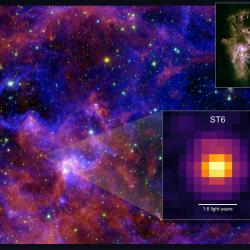Astronomers Discover Unique Spiral Galaxy with Twin “Jets” and “Halo”
With the help of citizen scientists, a team that includes University of Maryland astronomers has found an important new example of a very rare type of galaxy that may yield valuable insight on how galaxies developed in the early universe. The new discovery technique promises to give astronomers many more examples of this important and mysterious type of galaxy.
The galaxy they studied, named J1649+2635, nearly 800 million light-years from Earth, is a spiral galaxy, like our own Milky Way, but with prominent "jets" of subatomic particles propelled outward from its core at nearly the speed of light. The problem is that spiral galaxies are not supposed to have such large jets.
“The conventional wisdom is that such jets come only from elliptical galaxies that formed through the merger of spirals. We don't know how spirals can have these large jets,” said the study’s lead author Minnie Mao, of the National Radio Astronomy Observatory (NRAO).
J1649+2635 is only the fourth jet-emitting spiral galaxy discovered to date, and the first example of a "grand design" spiral galaxy with a large "halo" of visible-light emission surrounding it. UMD Astronomy Professor Sylvain Veilleux and graduate student Vicki Toy, two of the study’s co-authors, discovered the “halo” while observing the galaxy with the Discovery Channel Telescope near Flagstaff, Ariz.
“Our discovery supports the idea that the central bulge and halo of this galaxy may have been formed through a major galaxy merger, but the spiral structure formed later on,” said Veilleux. “The findings also indicate that J1649+2635 is the central member of a rich galaxy group that has likely undergone one or two major mergers in the past.”
A study detailing the discovery and appearance of J1649+2635 has been accepted for publication in the Monthly Notices of the Royal Astronomical Society. Mao and her colleagues dubbed these rare galaxies "Spiral DRAGNs," an acronym for the technical description, "Double-lobed Radio sources Associated with Galactic Nuclei."
Citizen scientists helped to find this unique spiral galaxy. Participants in an online project called the Galaxy Zoo look at images from the visible-light Sloan Digital Sky Survey and classify the galaxies as spiral, elliptical or other types. Multiple volunteers inspect each galaxy image to ensure accuracy in the classification. So far, more than 150,000 Galaxy Zoo participants have classified some 700,000 galaxies.
The research team used a subset of more than 65,000 galaxies, for which 95 percent of those viewing each galaxy's image agreed on the classification. About 35,000 were spiral galaxies. J1649+2635 had been classified by 31 Galaxy Zoo volunteers, 30 of whom agreed that it is a spiral.
Next, the researchers cross-matched the visible-light spirals with galaxies in a catalog that combines data from the NRAO Karl G. Jansky Very Large Array (VLA) Sky Survey and the Faint Images of the Radio Sky at Twenty Centimeters survey. They found that J1649+2635 is both a spiral galaxy and has powerful twin radio jets.
Jets such as those seen coming from J1649+2635 are propelled by the gravitational energy of a supermassive black hole at the core of the galaxy. Material pulled toward the black hole forms a rapidly rotating disk, and particles are accelerated outward along the poles of the disk. The collision that presumably forms an elliptical galaxy disrupts gas in the merging galaxies and provides "fuel" for the disk and acceleration mechanism. That same disruption, however, is expected to destroy any spiral structure as the galaxies merge into one.
“The next step will be to look for more examples of spiral galaxies with giant radio jets and a halo of light surrounding them in the nearby universe to better understand how common this phenomenon is,” said Veilleux.
Additional collaborators on this project included Frazer Owen, Emmanuel Momjian, Mark Lacy and Ryan Duffin of the NRAO; Bill Keel of the University of Alabama; Glenn Morrison of the University of Hawaii and the Canada-France-Hawaii Telescope; Tony Mroczkowski of the Naval Research Laboratory; Susan Neff of NASA's Goddard Space Flight Center; Ray Norris of CSIRO Astronomy and Space Science in Australia; and Henrique Schmitt of the Naval Research Laboratory.
The National Radio Astronomy Observatory is a facility of the National Science Foundation, operated under cooperative agreement by Associated Universities, Inc. This study used the Discovery Channel Telescope at Lowell Observatory. Lowell is a private, non-profit institution dedicated to astrophysical research and public appreciation of astronomy and operates the Discovery Channel Telescope in partnership with Boston University, the University of Maryland, the University of Toledo and Northern Arizona University.
Media Relations Contact: Abby Robinson, 301-405-5845, abbyr@umd.edu
Writers: Dave Finley/NRAO and Abby Robinson/UMD
University of Maryland
College of Computer, Mathematical, and Natural Sciences
2300 Symons Hall
College Park, MD 20742
www.cmns.umd.edu
@UMDscience
About the College of Computer, Mathematical, and Natural Sciences
The College of Computer, Mathematical, and Natural Sciences at the University of Maryland educates more than 7,000 future scientific leaders in its undergraduate and graduate programs each year. The college's 10 departments and more than a dozen interdisciplinary research centers foster scientific discovery with annual sponsored research funding exceeding $150 million.







